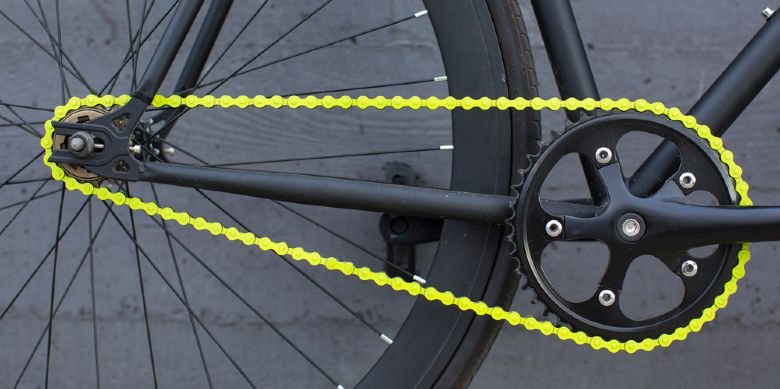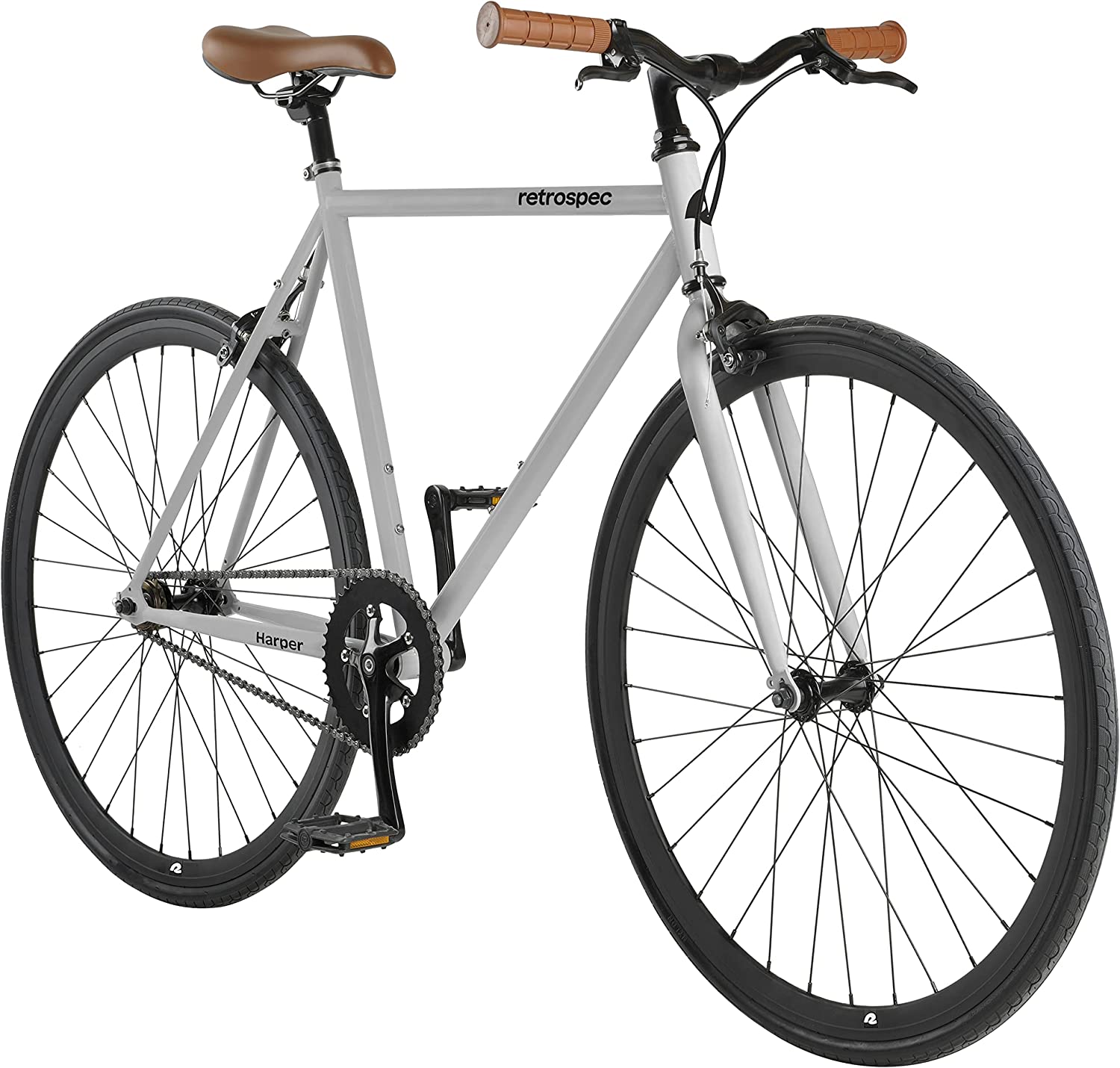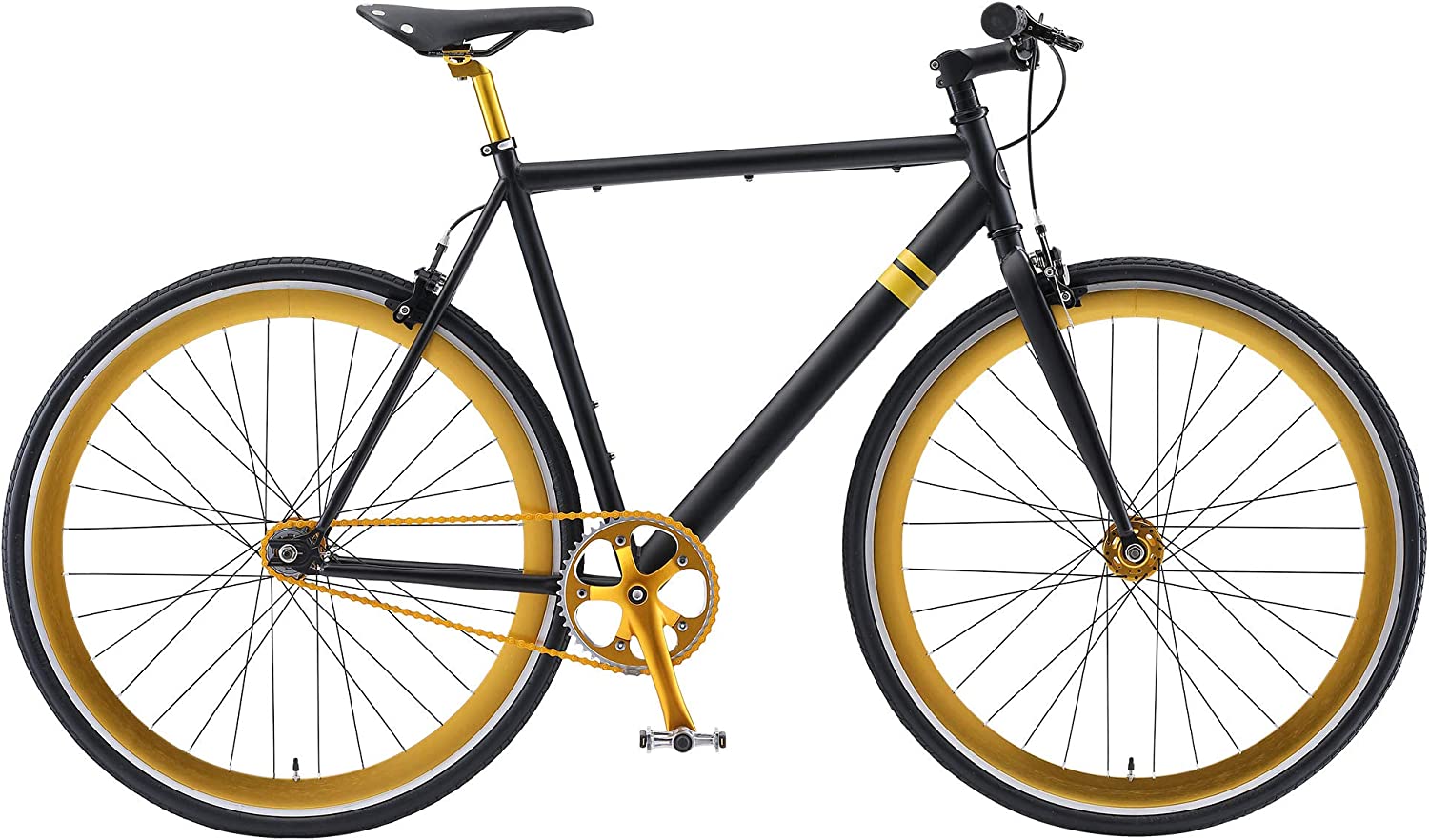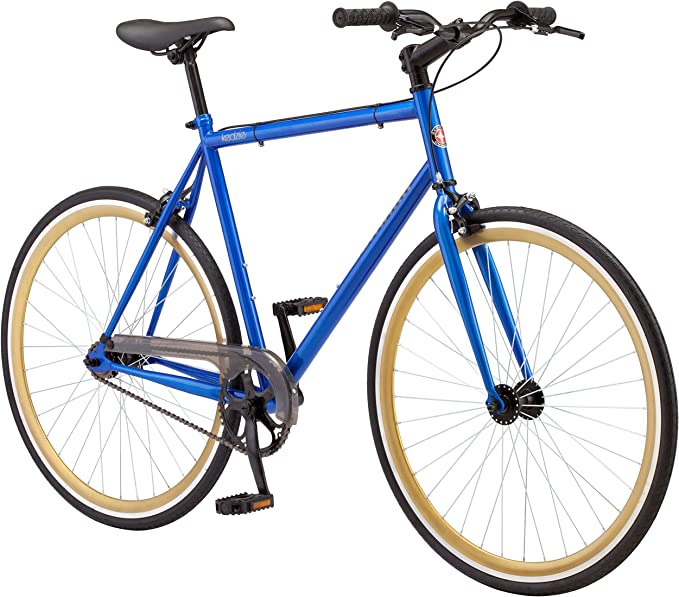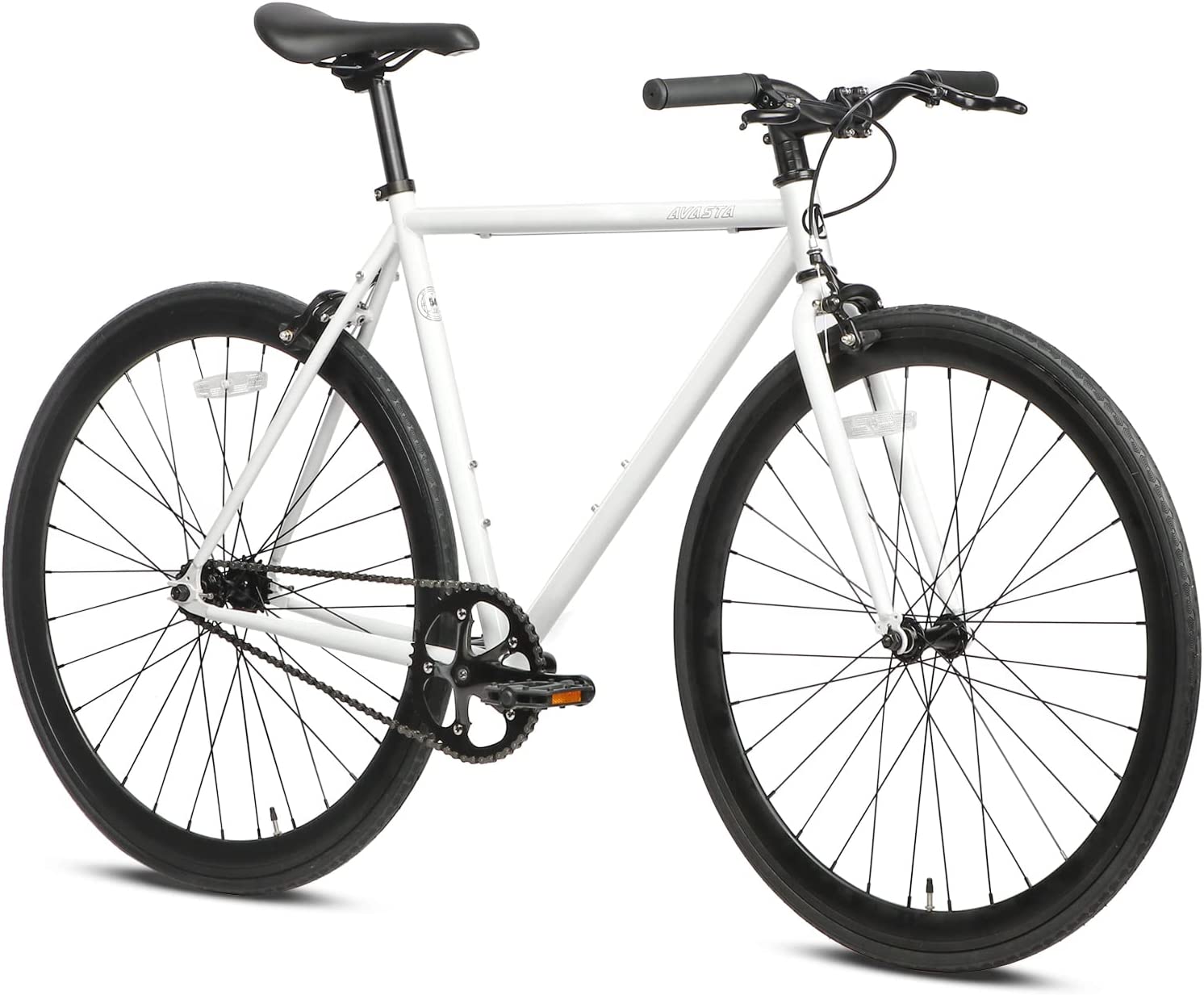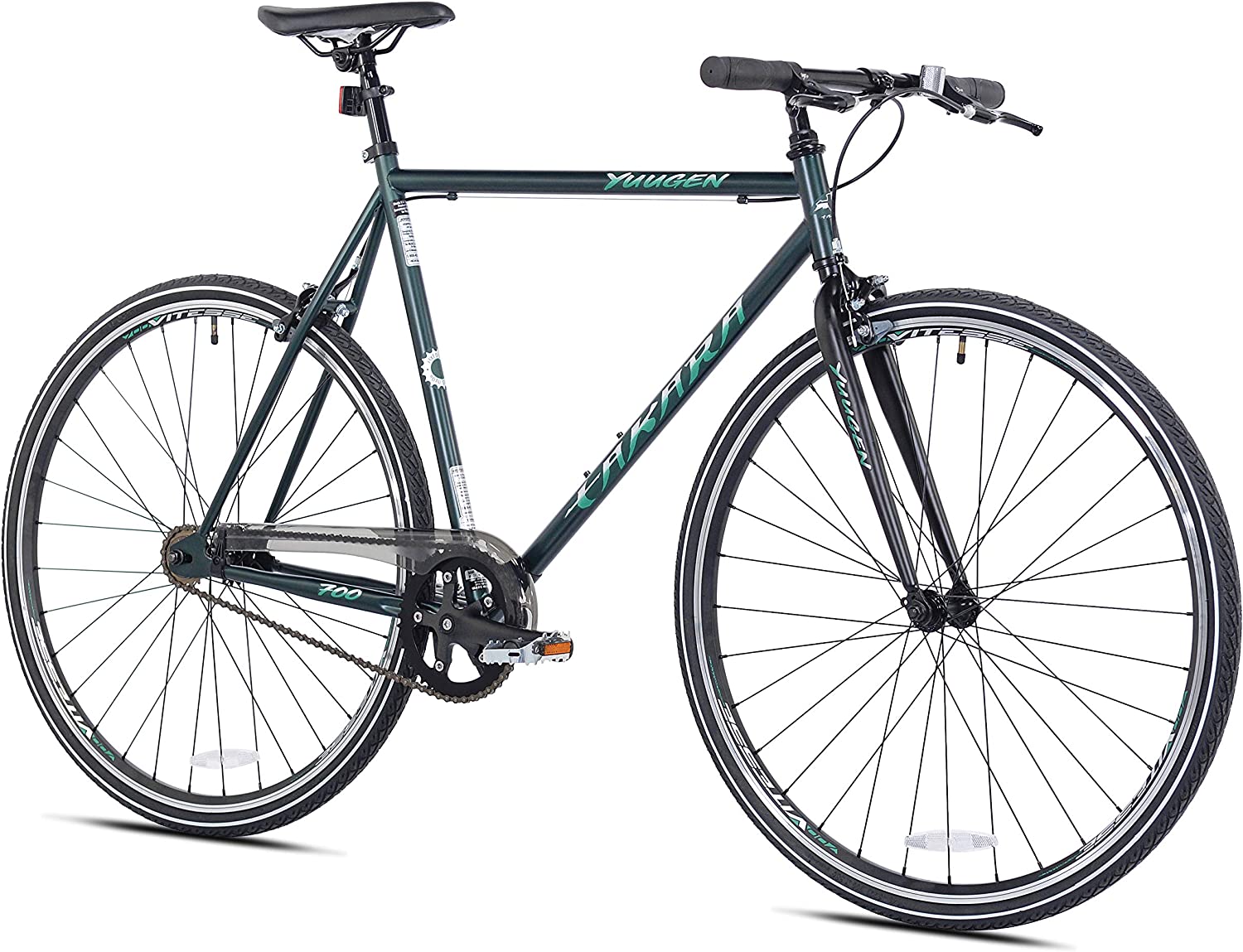A fixed gear bike, also known as a fixie, is a bike that gives you a non-complicated biking experience.
They’re affordable, lightweight, and low-maintenance. No wonder more and more riders are resorting to fixies for their daily commute around town.
If you’re considering joining the fixie bandwagon, then you’re in luck. I’ve reviewed seven of the best fixed bikes to help you make your decision.
The Best Fixed Gear Bikes In 2020
- Golden Cycles Single Speed Fixed Gear Bike (Best Choice)
- Retrospec Harper Single-Speed Fixed Gear (Premium Pick)
- 6KU Aluminum Fixed Gear Single-Speed (Best Value)
- Sole Fixed Gear Single Speed Fixie Bike
- Schwinn Kedzie Single Speed Fixed Bicycle
- Avasta Fixed Gear Single Speed Urban Fixie Road Bike
- Takara Yuugen Fixie Style Commuter Bike
1. Golden Cycles Single Speed Fixed Gear Bike (Best Choice)
Specifications
Weight: 23 lbs
- Frame Material: Steel
- Brake Type: Alloy Caliper Brakes
- Handlebars: Alloy Riser Handlebars
- Rear Hubs: Flip-flop hubs
This fixed gear bike from Golden Cycles is a great example of a value-priced fixie because it offers so much more than it lets on.
It may be more expensive than other fixed gear bikes, but it hits all the essential aspects and proves a lot in terms of color and style. It looks good and performs well.
You have a choice of 28 different color combinations ranging from black to interesting neon combinations. There’s something for everyone.
The fork and frame are made from tig-welded high-tensile steel, giving it that seamless appearance. The horizontal dropouts make the bike look aggressive and give it a stable ride.
It has a reasonable weight of 23 pounds. The bike also comes with a racing-style saddle that adds to its aggressive look and feel as well as two water bottle mounts.
The brakes on this bike are really worth the money. The front and back wheels have caliper brakes which are well placed and controlled levers that don’t get in the way. There are cables on the top tube that give it a cleaner look. The Golden Cycles bike can easily be upgraded or modified in several ways.
PROS
-
Smooth welding.
- Stylish and sturdy design.
- Lightweight.
- Flip-flop hub.
CONS
-
Some users feel that the brake levers are uncomfortable.
2. Retrospec Harper Single-Speed Fixed Gear (Premium Pick)
Specifications
Weight: 22 lbs
- Frame Material: Steel
- Brake Type: Caliper Brakes
- Handlebars: Riser Handlebars
- Rear Hubs: Flip-flop hubs
One reason people consider the Harper Single-Speed fixed gear bike as one of the best fixed gear bikes is because of the color choices and combinations as well as its glossy finish. It’s a good looking bike that will definitely catch your eye.
The bike has minimal working parts, which therefore reduces maintenance and its cost. The high-tensile steel frame is lightweight.
It has a flip-flop rear hub that allows you to ride in either freewheel mode or fixed gear mode. It’s quite an affordable bike when you compare it to other fixed gear bikes.
The instructions on the manual are easy to follow, making assembly a breeze, with users claiming that it can be assembled in 15 minutes from scratch.
The 25.4mm riser handlebars, VP freestyle pedals, front and rear Promax brakes, and KMC ⅛” chain help you maintain total control of your ride. The thick tires and the 30mm Deep V rims ensure that you have a smooth ride.
PROS
-
Affordable.
- Easy assembly.
- Requires minimal maintenance.
- Smooth and controlled ride.
CONS
-
Average quality brake pads.
- Some people find the saddle uncomfortable.
3. 6KU Aluminum Fixed Gear Single-Speed (Best Value)
Specifications
Weight: 21 lbs
- Frame Material: Aluminum
- Brake Type: Front And Rear Brakes
- Handlebars: Riser Handlebars
- Rear Hubs: Flip-Flop Hub
The 6KU urban track bike has interesting features that are not commonly found in city bikes. This model is a quality bike that’s great value for money.
The front and rear brakes can be removed easily. So if you want a bike that can stop and go easily as you maneuver the city streets, then you will enjoy this feature.
You can also remove the brakes for cleaning and adjustment—making maintenance affordable and easy. It’s also easy to shift riding modes from freewheeling to fixed gear because of the flip-flop hub.
As well as two color choices, you have the option of an aluminum or steel frame. The two models give you a choice for the right weight and feel for you. The steel frame is heavier, but it is more durable than aluminum.
PROS
-
Easy to remove brakes.
- Stainless steel dropouts are replaceable.
- Easy to assemble with basic tools.
- Two frame material choices.
CONS
-
Weak plastic pedals.
4. Sole Bicycles Fixed / Single Speed
Specifications
Weight: NA
- Frame Material: Steel
- Brake Type: Front Brakes
- Handlebars: Riser Handlebars
- Rear Hubs: Flip-flop Hub
The Sole is one of the best and most loved bikes on the market today. It’s both elegant and simple. Its strength, sturdiness, and durability are attributed to its durable steel frame and fork.
Riders appreciate its drome saddle that is customized for comfort. It has Flip Flop that makes it easy to change speeds from single to fixed gear.
You can easily remove the brakes on your own without getting expert assistance. The wheels on this bike are deep, dish-shaped wheels. The deep wheels cater for extreme durability, speed, and strength.
The depth also helps to absorb as much shock as possible when riding. The tires are able to retain air pressure after inflation, therefore withstanding long rides before having to be reinflated.
PROS
-
Budget-friendly.
- Durable steel frame.
- Lightweight.
- Smooth riding.
CONS
-
Some users have complained that parts come off easily after repeated use.
5. Schwinn Kenzie Single Speed Fixie
Specifications
Frame Material: Steel
- Brake Type: Caliper
- Handlebars: Flat
- Rear Hubs: Flip Flop
The Kedzie fixed gear bike has a very simple design. It’s available in blue and is an ideal bike for urban commuters who ride on flat surfaces.
The parts of the bike are easy to adjust and don’t require frequent changing, giving the rider worry-free use.
It has a steel frame that makes the bike strong and the ride smooth because the frame absorbs the vibration of the road. The fork strongly attaches to the rear wheel to increase torque power and rotating capacity of the wheel.
The model has a flip-flop hub that will give you the choice of freewheeling or fixed gear.
You can coast or cruise because the standard braking system gives you the ability to stop either way. The 30mm thick tire can be used in different weather conditions as it provides comfort, protection, and speed.
PROS
-
Simple adjustment.
- Deep tires for protection during rides.
- Easy to travel on flat ground.
- Flip-flop rear wheel hub
- Optimum speed.
CONS
-
Cheap pedals.
6. Avasta Fixed Gear Single Speed Urban Fixie Road Bike
Specifications
Weight: NA
- Frame Material: Steel
- Brake Type: Front and Rear Caliper Brakes
- Handlebars: Riser Handlebars
- Rear Hubs: Flip-Flop Hub
This bike by Avasta gives you a lot of aesthetic options to make you happy. It comes with a variety of fun colors to choose from.
It’s a great bike for both rough and smooth roads. You are assured of maintaining a constant speed as you ride the bike because of its single gear.
Although it comes with all the required tools, it’s a difficult bike for a novice to put together. It may be best for expert hands to handle the bike.
You are able to enjoy rides on both smooth and rough roads because of its sturdy steel body. It’s easy to carry this bike wherever you need to go because it’s of light nature.
You can get the model in a variety of sizes to choose from, therefore ensuring that your body comfortably fits.
This is a bike that fits both male and female adults. Children are not recommended to use this bike because it’s not safe for kids to handle a bike with narrow tires.
You have the option of a fixed wheel or freewheel ride. Therefore if you’re used to freewheeling, you can always switch to a freewheel ride as you adjust yourself to a fixed wheel and back as you would like.
PROS
-
Lockscrews in the track ends.
- Smooth ride.
- Sturdy and well-built bike.
- No adjustment or tuning required.
- Ideal for commuting.
CONS
-
Requires a professional for assembly.
- Seat is not the comfiest.
7. Takara Yuugen Coaster Fixie Style Commuter Bike
Specifications
Weight: 22 lbs
- Frame Material: Steel
- Brake Type: Coaster Brake and Normal brakes
- Handlebars: Riser Handlebars
- Rear Hubs: Freewheel
This Yuugen fixie is an affordable and cheerful bike that does the job of getting you from point A to point B. I love this bike because it’s pocket-friendly, but that doesn’t take away from its quality and functionality.
It has a handbuilt steel frame, making the bike a strong and sturdy option.
The front and rear brakes allow for safe, responsive, and quick stops. The VP freestyle pedals, front and rear Promax brakes, KMC ⅛” chain, and 25.4mm riser handlebars help you maintain total control of your ride.
The lightweight rims and thick stable tires give you a smooth ride with a good grip of the road, regardless of the weather conditions.
The Yuugen has a coaster brake that allows for smooth slows and stops. This brake mechanism is integrated into the pedals. If you don’t want that you can flip the rear wheel and just use the standard brakes.
If you wish to stop, all you have to do is pedal backward. Coaster brakes make stops softer and less abrupt. These types of brakes don’t have any external elements, thereby reducing the overall maintenance cost.
PROS
-
One year warranty.
- Comfortable saddle.
- Variety in choosing handlebar, water bottle cage, saddles, and foot-strap.
- Fast and durable.
CONS
-
In order to be accorded the one-year warranty, you must have the bike assembled by a professional, which could be pricey.
What is The Best Fixed Gear Bike of 2020?
Fixed gear bikes are versatile bikes for the city and track. They are great for pleasure rides, running errands, commuting, and breaking a sweat by getting a good workout.
My clear standout bike is the Golden Cycles Single Speed Fixed Gear Bike with Front & Rear Brakes.
It may cost more than other fixies, but it definitely outperforms them. It’s a good looking bike with many color options. It isn’t all looks, though, because of its smooth welding and quality components that offer a great ride and hold up over time.
It’s a comfortable bike to ride with great brakes and has a lightweight feel when riding. The flip-flop hub gives you the flexibility to decide how you want to ride, either fixed or freewheel.
All in all, it’s a functional, comfortable, and beautiful fixed gear bike and great for your daily commute.
Buying Guide
What Is a Fixed Gear Bike?
A fixed gear bike is also fondly referred to as a fixie, but how does it work? Well, the gear cog in a fixie doesn’t have a bearing in it. It is literally fixed to the back wheel. Normally, a ball bearing system will enable the wheel to spin even when the cog isn’t spinning; they are independent of each other.
This isn’t the case on a fixie. This means that when you pedal backward, the bike also moves backward. It’s that simple! It’s an easy bike to ride with fewer parts, making it significantly lighter than other bikes.
I personally enjoy riding my fixie bike because it’s light and has great maneuverability when I’m out and about the town. Riding a fixie almost feels like you’re riding an extension of yourself. The movement of the bike is directly tied to your pedaling. It also has a reliable braking system.
Why Should You Buy a Fixie?
You should buy a fixie because of the simplicity it offers. Fixie bikes are all the rage right now. (1) They are among the best bikes suitable for urban rides, as long as you don’t go through long, steep hills on your daily commute. A fixie doesn’t have shifters, so you can focus your attention on your riding, and you will have more control because your bike’s speed is directly controlled through the transmission.
If you’re a rider but not used to riding a fixie bike, then it might take some getting used to. Not that it’s particularly complicated, but coasting to a halt is something you would have to unlearn. The minute you straighten your knees, the bike comes to a halt, and you could find yourself still moving forward with your bike halted behind you.
Components of a Fixie
These are the main components that make up a fixie:
Frame and Fork
The frame and fork determine the dimensions of the bike. Together with the handlebars, the frame and fork also influence your riding style. Those fixies made for racing are designed to favor a forward-leaning position. The fixies that are dedicated to the daily commute within the city influence a more upright position.
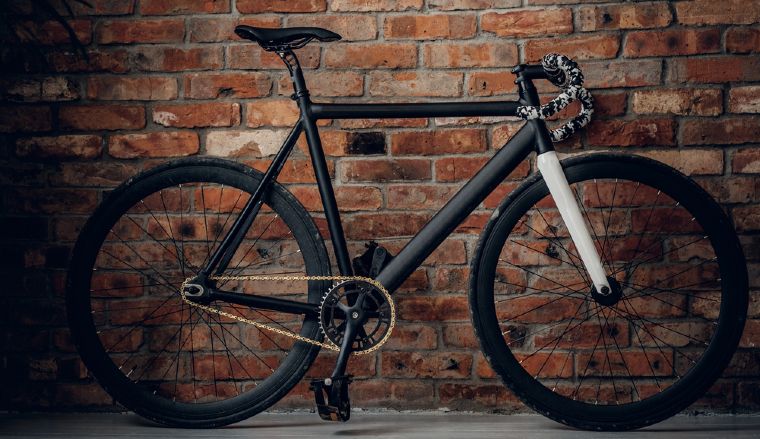
Here are three main fixie frame materials:
Aluminum and Aluminum Alloy
These are common materials that are among the best when it comes to shock absorption plus they are lightweight. Aluminum and its alloys are affordable and can resist corrosion and rust.
Related Article: How to Remove Rust From a Bike Chain?
Steel
Steel, as we all know, is heavy. It adds to the overall weight of the bike, but it also ensures that the bike is strong. When exposed to the elements, steel easily introduces rust and corrosion. It does, however, make for a smooth and comfortable ride.
Carbon Fiber
Carbon fiber frame components are found in some high-grade fixies. The carbon fiber makes the bike sturdy and light.(2)
Handlebars
Fixies have different types of handlebars that influence the way you ride your bike. These bars are normally short and flat:
- Flat bar: The flat bar is the most popular handlebar choice for fixies. There are riders who prefer very short bars that have narrow brakes. This affects maneuvering because when cornering, you have to turn the handle less. When riding a flat bar, however, the height and distance to the seat will determine how forward-leaning or upright you are when riding.
- Riser bar: This handlebar is uncommon in the fixie department. It often features a variation, the mustache bar, which is only slightly swept back and minimally curled.
- Drop bar: Drop bars are normally used for racing. They enable you to ride aerodynamically in a lowered position if you prefer it.
- Bullhorns: Bullhorns are featured on riser/mustache bar or flat bar. This enables you to grip a perpendicular handle in a position that’s more forward-leaning, normally intended for racing or simply going fast.
Wheels and Tires
Most fixie bikes have 700c tires. 700c refers to any tire, rim, or wheel with a 622mm bead seat diameter, or BSD. The models that are best designed for racing or are simply more aggressive have narrow wheels and minimal tires with deep rims that are normally seen on track bikes.
Where you intend to ride your bike influences the tire width. If you simply aim to ride your bike for commuting purposes on the streets and not to race, then it’s best to look for slightly wider tires with some profile, at least.
Brakes
Fixies usually only feature a front brake. This allows you to slow down simply by locking the pedals. Single speed bikes normally come with a front and rear brake for safety purposes. It is rare to find disc brakes on fixies, but they are there.
Some riders prefer to remove the brakes off their fixie bikes so they can brake manually. Most fixies have cabling that allows you to remove all your brakes or one of them if you want to. However, before you go ahead and remove your brakes, please check your local regulations first. It may be prohibited by law to ride a bike that doesn’t have brakes.
Seat
Most fixed gear bikes use narrow and swept seats that are found in racing and track bikes. Cushioning can be included with your purchase, slightly padded or otherwise, depending on the model.

Fixed Gear vs. Single Speed Bikes
On a surface level, a fixie and a single speed bike are very similar. They both essentially have one gear. In fact, many people assume that a fixie is the same as a single speed bike. They are, however, two completely different types of bikes.
You’ll find that a single speed bike has a freewheel fitted in whereas a fixie bike does not. The rear cog on a fixie is joined with the rear hub. This means that when the wheel turns, the cog also turns.
When you stop pedaling on a single speed bike, the back wheel continues to turn. The pedal arms/cranks, however, will not. If you stop pedaling on a fixie, the cranks continue spinning. This means that for the fixie bike to keep moving, then you have to keep pedaling.
The concept of coasting does not exist in fixies. You can stop the bike from moving by preventing the pedals from moving.
The Flip-Flop Hub
The flip-flop hub is also known as a double-side hub. It is a rear-wheel hub that allows for either two fixed gear cogs on either side or a freewheel on one side and a fixed gear cog on the other side. There are two main double side hubs:
Running Two Fixed Gear Cogs
Most people prefer to have two fixed gear cogs because of versatility. If you run two rear cogs that are sized differently, then you have the ability to change them depending on the environment.
If you’re riding in a flat area where speed is the priority, then you might use a lower number of teeth. Riding a lower number of teeth in the rear cog enables you to reach top speed quite easily. When you get to a hilly area, however, pedaling will prove quite difficult.
When you come across steep hills, you can change to a higher number of teeth to make the climb easier and reduce the stress on your legs. Running two fixed gear cogs gives you the option to ride in different conditions without needing an internal hub of a derailleur.
Running Fixed Gear and Freewheel
The best thing about this is that you get to have the best of both worlds in one by enjoying the benefits of both fixed gear and freewheel in one bike. If you want to get a lot of exercise done, you can use the fixed gear. When you decide to go for a chill ride around town that doesn’t require much of your physical input, you have the option of switching to freewheel.
Fixed Gear Bike Weight
A fixie bike only features a singular gear; therefore, there’s not much to add on that increases the weight. These simple bikes weigh an average of 21 pounds. Even with a steel-frame, a fixie should weigh less than 20 pounds. The lighter it is, the easier it is to maneuver and stop while riding.
Gear Ratio
Before you purchase a fixed gear bike, it’s important to find the right gear ratio. The most common ratios are 46:16 and 44:16. Technically there is no “right ratio” because certain bikes are made for specific ratios.
Here are some of the best tips to help you understand:
You can get a gear ratio by determining the number of teeth in the chain rig. My personal recommendation is to ride a fixed gear bike that has 44 or 46 teeth in the chain rig. This is where you get the first number in the ratio. The rear cog teeth account for the last number in the ratio; I recommend 16.
The 44/16 ratio is sometimes referred to as 2.75. It allows for easy acceleration; however, it has low top speeds. It’s most suited for leisurely rides. It’s great for daily work commutes and casual weekend rides with family or friends. If you live in a predominantly flat area, this gear ratio will be the best choice for you.
The 46/16 ratio, also referred to as 2.88 ratio has higher top speeds, however, acceleration is more difficult. The 46/16 allows you to travel further with less effort. These bikes are great for performance-related rides such as distance races.
Size and Fit
Most bike manufacturers offer a sizing chart that will help you choose the correct size that best compliments your body’s dimensions. These size charts have large, medium, and small options for you to pick the one that suits you best.
An important detail to consider when choosing size is the “standover height.” If you are standing over the bike with both feet placed firmly flat on the ground, there should be an inch clearance space between the crotch of your pants and the top tube.
How to Use Your Fixed Gear Bike — Beginner Tips
If you’re new to riding, there’s nothing to be scared of. Bike riding is an intense thrill. There are instructional tutorials online that can help ease your jitters. However, you’ll find that they all point towards one thing for you to do; just start.
If you’ve ridden a freewheel bike before and you want to try the fixed gear bike, you’re surely in for a different experience. You might have to forgive some people for mistaking you for a first-time bike rider, but with enough practice, you’ll get the hang of it soon enough.
Here are some tips to get you riding your fixie:
Always Pedal
Seems easy enough, right? Freewheel bikes give you the luxury of movement even when you’re not pedaling. With a fixed gear bike, once you stop pedaling, the bike stops along with you.
Using Your Brakes
There is an assumption common among cyclists that you are better on your bike if you ride without brakes. Nothing could be further from the truth.
Do not remove your brakes, especially if you’re starting out. It’s safer for you, beginner or not. Removing the brakes might make the bike lighter but this won’t make much of a difference if you’re not a professional cycling competitor. It’s best to leave the front brakes on to ensure safety.
Track Standing
Track standing is considered an art practice by most people. Track standing on a fixed gear bike is easier because the bike has better balance, and you’ll have even more control over your bike when you’re operating at slower speeds.
When Not to Track Stand
I know I said that track standing is an art. However, it’s not something you need to do a lot. Many people overuse the skill and end up stopping traffic in order to do a track stand. Here are tips that will guide you as you track stand to avoid causing inconvenience to yourself or the general public.
Keep Yourself Strapped
Everything is mechanical with these sort of bikes. The pedals may decide to move whether your legs are moving or not because the bike is in motion. The last thing you want is for your feet to slip off from the pedals. If that happens, you can imagine trying to place your feet back with your pedals spinning at 100 RPM.
Stopping Your Bike
Now that we’ve agreed that track stands are best for the track back home, there are two ways of stopping; stopping with the pedals left in a position that allows for acceleration or using the front brake to lift the rear wheel slightly off the ground and allow your leading foot (human rear brake) to get in position.
It may sound complicated, but that’s a trick you could learn in no time.
Spinning Downhill
You don’t want to spin uncontrollably down a steep hill. Other than looking a bit ridiculous, it’s dangerous. Learning how to control down a hill is difficult but necessary. Master how to get the best control of your bike and roll gently down the hill. The brakes come in handy here.
Getting the Right Chain Tension and a Straight Chainline
You want to get the tension nice and right before you start riding. If it’s too tight, you’ll have great difficulty turning the cogs. Similarly, if it’s too loose, you could risk getting seriously injured if the chain was to jump off.
With this in mind, you should strive to have the chain as tight as possible yet still give the drive chain free movement. Getting a straight chainline will ensure that the connection between chain and cogs is good, therefore minimizing the chances of you slipping off.
Bunny Hop While Pedaling
This is not mandatory, but it’s a good trick to master for fixed gear bike riding. Start slowly and work your way up. Because once you get this trick right, it will be far more useful than track stands and skidding. It will help you maneuver those pesky potholes.
Flares and Laces
The last thing you need when riding is to have your laces or flare pants getting stuck in your fixed gear chain. Do a quick check before you set out.
Dress Appropriately
Another one of those tips that will do nothing to add on to your skillset, but you might as well to look good. You’re riding a single gear bike, after all. Let the road users know who they’re dealing with.
Ride Carefully
Another misconception I seem to see with bike riders is that road rules don’t apply to them. Road rules are there for your safety and those around you. Stay safe.(3)
FAQ
I’d say that the main difference between a single speed bike and a fixie is the ride experience. The cog in a fixie is joined to the hub. When the pedals turn, the cogs turn. When the cogs turn, the rear wheel turns. This means that every move you make with the pedal directly affects the bike.
Single speed bikes come fitted with a freewheel cog, which rotates one way and locks up the other way. The movement of single speed bikes is, therefore, not heavily dependent on the pedaling, and you have an easier time riding.
Yes, they do, but they are not necessary. Many riders resist the pedal motion with their legs or skid the rear well, effectively coming to a stop. Other bikes can’t do this because of their freewheeling nature.
Well, I’d say yes and no. Yes, because if you stop pedaling, the bike stops. No, because many riders stop pedaling so that they can coast. Bike pedals on fixies are directly connected to the rear wheel. You, therefore, have to keep pedaling if you want the bike to keep moving.
Many fitness enthusiasts prefer fixies because they get to break a sweat when riding one. You constantly have to put in work to continue moving, so you are assured of a good workout. Many bikers also just love that feeling of being at one with their bikes.
I’d say they’re best for commuting. You have less to think about in terms of gear changing; therefore, you can peacefully ride and clear your mind. They’re affordable to purchase, affordable to maintain, and easy to maneuver. Honestly, if you don’t live in a hilly area, the fixie bike can prove one of the best commuting options for you.
Best Fixed Gear Bikes Review
I’ve put together seven of my favorite fixed gear bikes to help give you some insight before you make your final decision:
References
- Loyd Alter – Real Estate Development Tip: Follow the Fixies, retrieved from https://www.treehugger.com/real-estate-development-tip-follow-fixies-4848450
- ToughtCo. – How Is Carbon Fiber Made? Retrieved from https://www.utsi.edu/carbon-fiber
- Webmd – Bicycle Safety, retrieved from https://www.webmd.com/fitness-exercise/bicycle-safety#1
